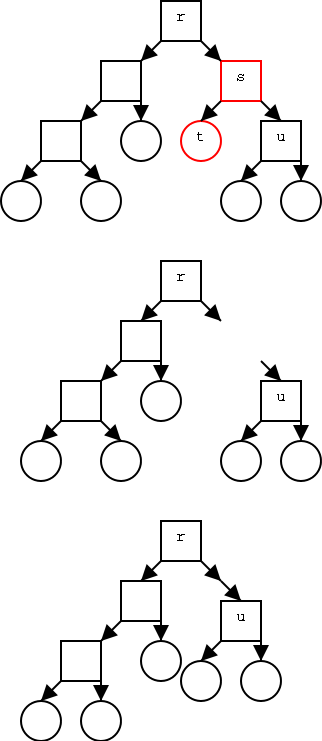Note: The following homework should have been assigned last time but wasn't so it is part of homework 9.
Homework: R-2.3
Remarks:
Problem Set 2, Problem 1. Note that the height of a tree is the depth of a deepest node. Extend the height algorithm so that it returns in addition to the height the v.element() for some v that is of maximal depth.
Recall that a binary tree is an ordered tree in which no node has more than two children. The left child is ordered before the right child.
The book adopts the convention that, unless otherwise mentioned, the term "binary tree" will mean "proper binary tree", i.e., all internal nodes have two children. This is a little convenient, but not a big deal. If you instead permitted non-proper binary trees, you would test if a left child existed before traversing it (similarly for right child.)
Will do binary preorder (first visit the node, then the left subtree, then the right subtree, binary postorder (left subtree, right subtree, node) and then inorder (left subtree, node, right subtree).
We have three (accessor) methods in addition to the general tree methods.
Remark: I will not hold you responsible for the proofs of the theorems.
Theorem: Let T be a binary tree having height h and n nodes. Then
Proof:
Base case n=1: Clearly true for all trees having only one node.
Induction hypothesis: Assume true for all trees having at most k nodes.
Main inductive step: prove the assertion for all trees having k+1 nodes. Let T be a tree with k nodes and let h be the height of T.
Remove the root of T. The two subtrees produced each have no
more than k nodes so satisfy the assertion. Since each has height
at most h-1, each has at most 2h-1 leaves. At least
one of the subtrees has height exactly h-1 and hence has at least
h leaves. Put the original tree back together.
One subtree
has at least h leaves, the other has at least 1, so the original
tree has at least h+1. Each subtree has at most 2h-1
leaves and the original root is not a leaf, so the original has at
most 2h leaves.

Theorem:In a binary tree T, the number of leaves is 1 more than the number of internal nodes.
Proof: Again induction on the number of nodes. Clearly true for one node. Assume true for trees with up to n nodes and let T be a tree with n+1 nodes. For example T is the top tree on the right.
Alternate Proof (does not use the pictures):
Corollary: A binary tree has an odd number of nodes.
Proof: #nodes = #leaves + #internal = 2(#internal)+1.
Algorithm binaryPreorder(T,v)
Visit node v
if T.isInternal(v) then
binaryPreorder(T,T.leftChild(v))
binaryPreorder(T,T.rightChild(v))
Algorithm binaryPretorder(T) binaryPreorder(T,T.root())
Algorithm binaryPostorder(T,v)
if T.isInternal(v) then
binaryPostorder(T,T.leftChild(v))
binaryPostorder(T,T.rightChild(v))
Visit node v
Algorithm binaryPosttorder(T) binaryPostorder(T,T.root())
Algorithm binaryInorder(T,v)
if T.isInternal(v) then
binaryInorder(T,T.leftChild(v))
Visit node v
if T.isInternal(v) then
binaryInorder(T,T.rightChild(v))
Algorithm binaryIntorder(T) binaryPostorder(T,T.root())